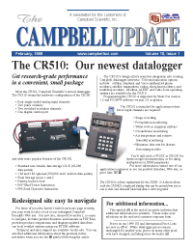Campbell Scientific now offers Argos satellite telemetry as a standard method of data retrieval. Argos telemetry features one-way data transmission from remote sites to ground stations via Argos Polar Orbiting Environmental Satellites. The system is administered in the U.S. by Service Argos and is dedicated to monitoring and protecting the environment. CSI applications include meteorology (automated weather stations in Antarctica), oceanography (ocean buoys in the Atlantic Ocean), and water resources management (Amazon River Basins).
Because the satellites are polar orbiting, the number of passes over a given geographic location is a function of the site’s latitude. In general, there are about 28 passes per day over the North and South Poles and about eight passes per day at a given location along the equator. The satellite is overhead for about 10 minutes per pass. Most users are allowed to transmit a one-second duration data stream every 90 or 200 seconds. The data stream equates to 16 CSI low-resolution data points. Because the transmitter does not "know" when the satellite is overhead, a data stream must be re-transmitted during a number of intervals to ensure reception. In general, the higher the site’s latitude and the less redundancy required to ensure all data is captured, the more data can be transmitted.
Data Delivery
The satellites receive data messages from users’ transmitters and store them on tape. When the satellites pass over one of the Argos ground stations they read out ("dump") the data. From there data is electronically forwarded to processing centres where the raw data is extracted from the satellite data sets. From that point, accessing the data is easy. The user can retrieve results from anywhere in the world by public data networks, often within 20 minutes of transmission. Service Argos currently offers data delivery via Internet e-mail, Internet Telnet session, and dial-in modem. Other delivery services include diskette, tape, and hard copy. It is important to note when the data is collected, the user is required to convert the raw binary data back into a decimal format. The Argos satellite instruction manual (supplied with each system) provides details on accomplishing this conversion.
Satellite Hardware and Data Logger Firmware
Campbell Scientific offers the Argos-Certified ST-13 Transmitter (from Telonics, the same manufacturer as our GOES-Certified TGT1 Transmitter), a synchronous interface and cable, a test receiver, and an optional marine half-wave antenna with mounts. Instruction 121, standard in CR500, CR510, CR10X, and CR23X operating systems, is required for Argos telemetry. Instruction 121 is available for the CR10 as a Library Special EPROM. The transmitter is interfaced to the data logger’s nine-pin CS I/O port. The ST-13 requires 7-14 VDC. Current consumption is 525 mA at 14 VDC during the one-second transmissions. Quiescent current is less than 100 µA. System power budgets are less than 0.2 Ahrs per day for the ST-13 transmitter and interface.
Using the ARGOS System
A formal application process is required to send data via Argos. There is also a monthly charge to use the system. Because a radio signal is sent to the satellite, users must contact their national telecommunications authority for authorization to use the Argos Uplink frequency (401.650 MHz). Users in the United States must apply for a Federal Communications Commission (FCC) License. FCC forms 552 and 159/159C are required.

